At its most simple, sushi is just a delicious Japanese dish. As soon as you add the extra deep flavors of perfectly executed sushi sauces to it, sushi becomes divine.
Your makizushi and narezushi will burst with flavors by simply adding traditional teriyaki or ponzu sauce to them.
You can also make it a little more exotic by adding a Korean spicy sauce. You’re sure to make your guests drool and lick their fingers down to the last piece.
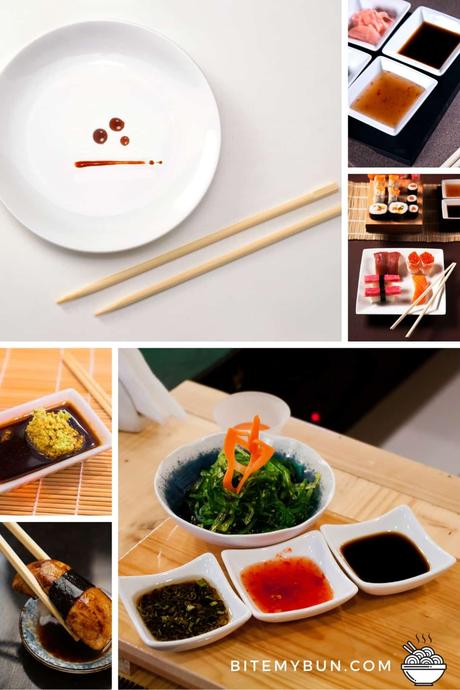
If you’re in a hurry, let me share my 3 favorite ready-made sushi sauces with you, after that, we’ll get more into different flavors and options you have:
Sushi Sauces Images
Best sushi soy sauce dip: San-J Tamari Sauce
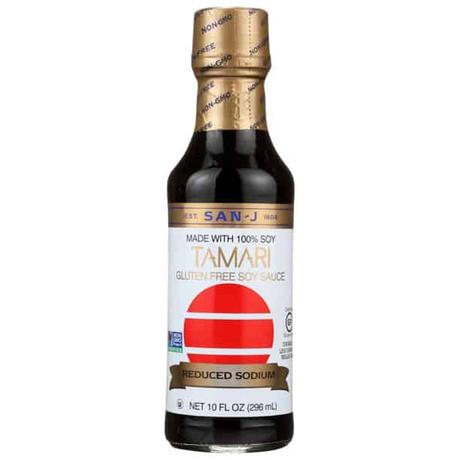
Best for glazing: Kikkoman Teriyaki sauce

(view more images)
Brown sauce on top of sushi: Otajoy Nitsume Eel sauce
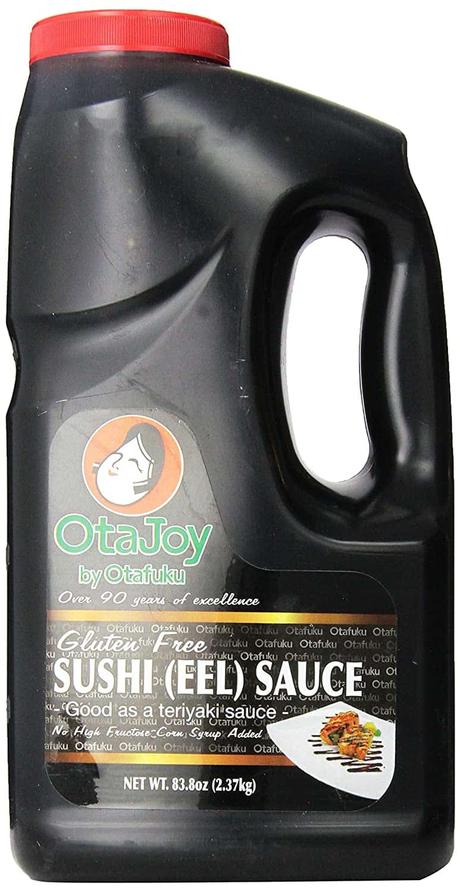
(view more images)
Spicy red sushi sauce: Sarayo Spicy Mayonnaise
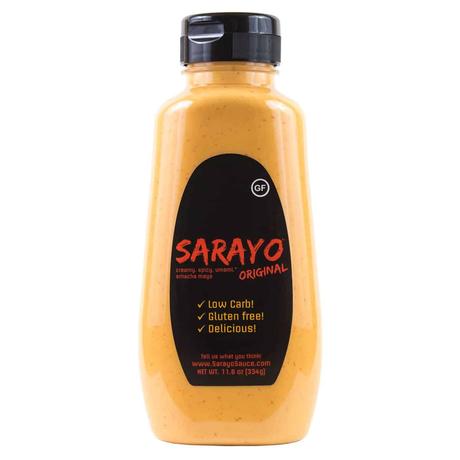
(view more images)
Sesame ginger dressing: Kewpie Deep Roasted
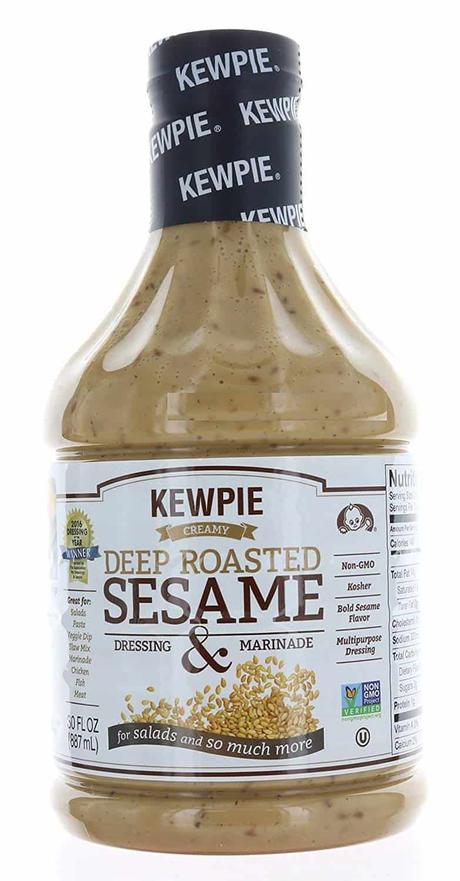
(view more images)
Miso Mayo: So Good Original
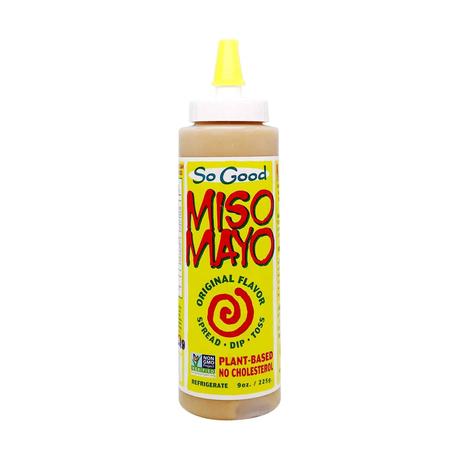
(view more images)
Sesame oil, miso, sake & more: Ebara Gomadare
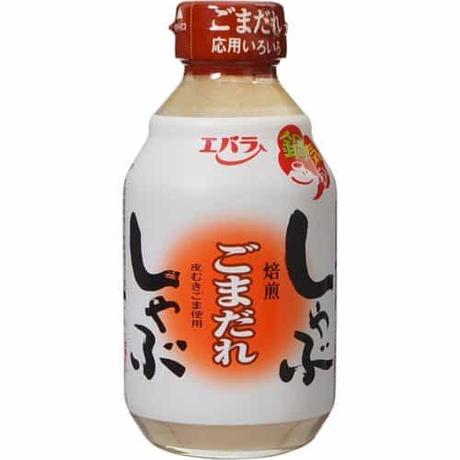
(view more images)
Citrus-soy ponzu sauce: Kikkoman
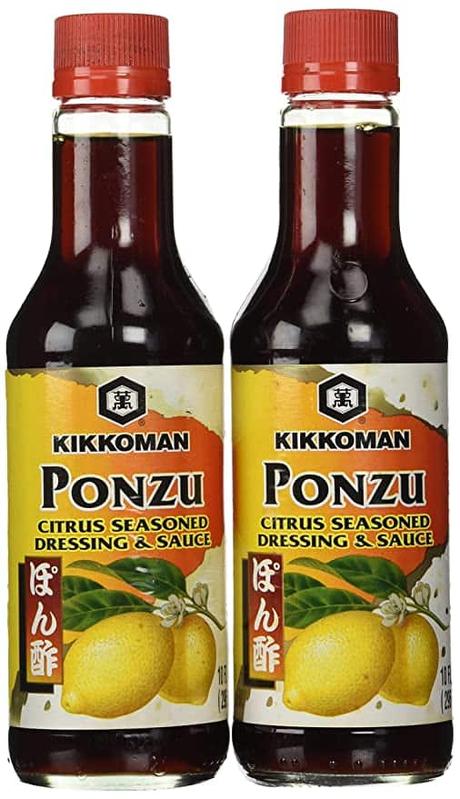
(view more images)
Yum Yum sauce (Sakura white sauce): Terry Ho’s
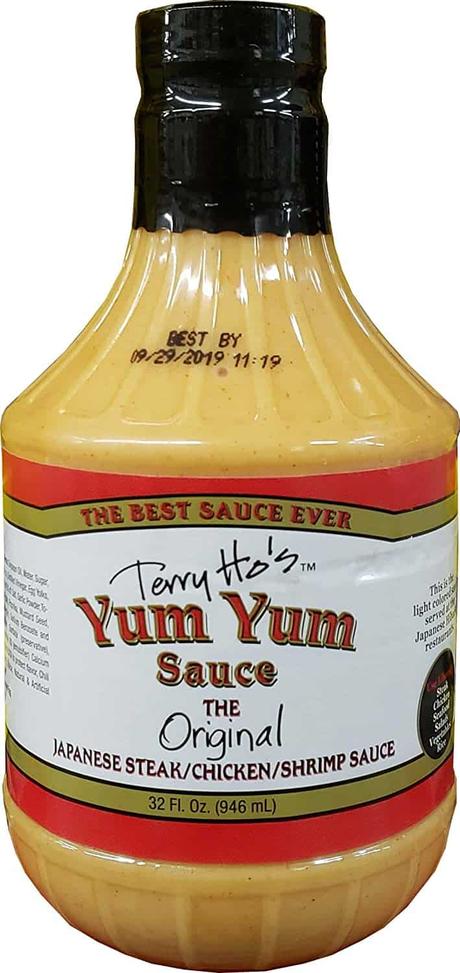
(view more images)
If you already know and use the traditional black, sweet, and spicy sushi sauce, then you can also switch it up with the Japanese spicy mayo or ginger mayo sauce.
This provides an alternative flavor that you can choose between variations of sushi sauces whenever you make sushi meals for whatever the occasion is.
You may also try a carrot ginger sauce for a refreshing flavor. It gives your sushi dish a new funky color that’s quite pleasing to the eyes.
How to make sushi also has these 3 great sauce recipes on their channel:
Try these 9 Best Sushi Sauces
Here is our list of the top 9 sushi sauces plus a bonus wasabi sauce recipe for fans of spicy food!
Tamari Sauce
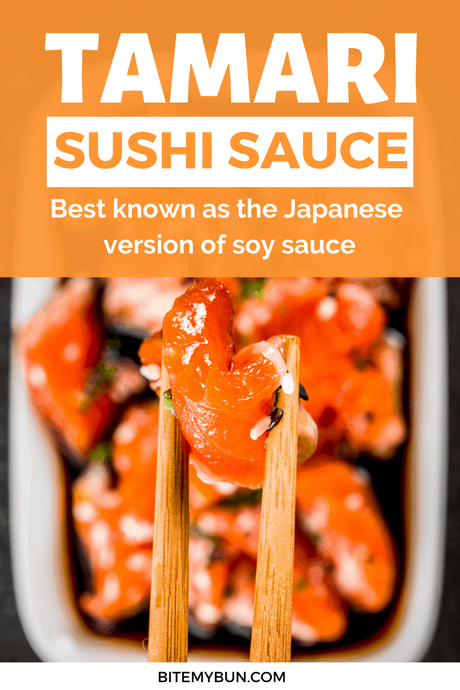
Best known as the Japanese version of soy sauce, but is vastly different from its Chinese analog.
The tamari sauce is fermented with less wheat which causes it to have a less salty flavor and thicker consistency.
Like dashi, the tamari sauce is also used in a variety of Japanese foods in order to add a savory umami flavor to them.
Tamari is the by-product of miso paste and is completely different from the Chinese soybean. The latter is made by cooking soybeans with roasted wheat.
Almost no wheat is added to the product during the fermentation process, which makes it the perfect sushi sauce for people who are gluten intolerant.
What sauce comes with sushi rolls?
Most sushi restaurants will prefer to use tamari sauce over soy sauce. They mix it in when cooking their in-house recipes as well as serve it as a dipping sauce to use on the slices of sashimi fish and nigiri sushi.
If you are on a celiac diet, then you can ask the chef to only serve you gluten-free tamari sauce and food on the menu.
You’re certainly not going to make a sauce like this yourself because of the extensive fermentation process involved, but I’ve found this San-J tamari sauce on Amazon to be excellent and very tasty!
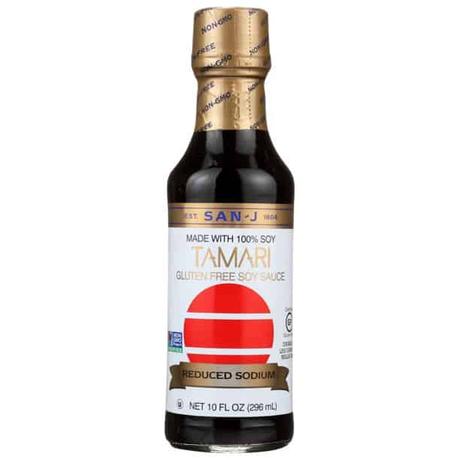
(view more images)
And of course, it’s gluten-free.
Teriyaki Sauce
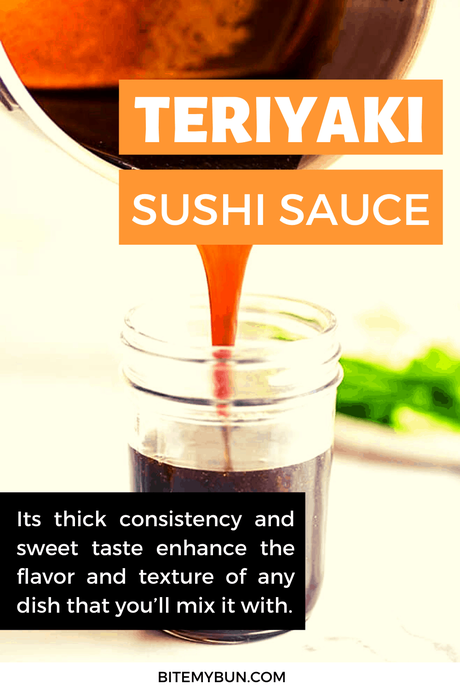
This is the black and sticky version of the soy sauce that’s used for glazing the fish on top of sushi.
Sometimes the sushi chef also uses it to drizzle over the California roll toppings in order to enhance its flavor. It possesses a strong flavor and has a thicker consistency, which makes it a good pair with a variety of dishes.
 Print
Print
Sushi sauce Japanese Teriyaki
How to make teriyaki sushi sauce at home: Course Main CourseCuisine JapaneseKeyword Sauce, Sushi Prep Time 10 minutesTotal Time 10 minutes Servings 4 people Author Joost Nusselder Cost $1Ingredients
- 1 cup water
- ¼ cup soy sauce
- 5 tsp packed brown sugar
- 1 tbsp honey or more to taste
- ½ tsp ground ginger
- ¼ tsp garlic powder
- 2 tbsp corn starch
Instructions
- Get a saucepan and place it on top of a stove as you set the temperature to medium heat, then mix all the ingredients mentioned above, except for the cornstarch and cold water.
- Pour the cornstarch and 1/4 cup cold water in a separate bowl and whisk them together, then add this mixture to the other ingredients that you’ve placed in the saucepan earlier.
- Bring to boil and then simmer and adjust temperature and cook time to achieve desired consistency.
- Remember to add water if the sauce becomes too thick in order to soften it.
- Once you’re satisfied with the thickness consistency, then turn off the stove and transfer the sauce to a glass bottle and refrigerate.
Eel Sauce (Nitsume)
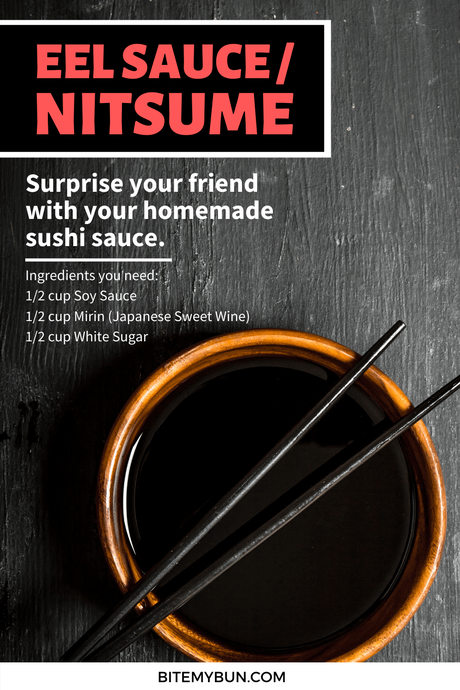 If your friends have been eating sushi for a while now and have fallen in love with the black sushi sauce, then surprise them by telling them you’ve made a homemade version of it!
If your friends have been eating sushi for a while now and have fallen in love with the black sushi sauce, then surprise them by telling them you’ve made a homemade version of it!
The Japanese call it nitsume and it is often used to blast or drizzle on grilled eel and other fish toppings on sushi.
The eel sauce has a sweet and salty flavor that goes well with most sushi dishes.
If you want to make eel sauce at home, then you will need to prepare these ingredients:
- 1/2 cup soy sauce mixed with
- 1/2 cup mirin (Japanese sweet wine)
- and 1/2 cup white sugar
Get a saucepan and place it on the stove, mix all ingredients as you bring them to a boil. Now let it simmer until the liquid mixture reduces to 3/4th from its original volume measured from the brim of the saucepan.
Once the sauce cools down, transfer it to a clean glass jar and refrigerate.
Is eel sauce like oyster sauce?
Many people confuse eel sauce and oyster sauce. These two sauces share some similarities but the texture of the eel sauce is much more liquidy. Oyster sauce is thick and in some cases, it doesn’t contain any oyster, only an extract. Eel sauce is meant to be used as a topping on other eel dishes.
What does eel sauce taste like?
Eel sauce has a distinct and unique flavor. But, it’s most notable because it has a mixture of flavors combined into one sauce. It has a traditional Japanese umami flavor, a sweet flavor, saltiness, and a hint of smokiness. Since it tastes different from other sauces, the exact flavor is hard to describe. Some people even go as far as to say eel sauce is similar to BBQ sauce.
Tonkatsu Sauce
Much like the 2 previous sauces, this too is a tastier and thicker version of soy sauce. In Japan, they serve Tonkatsu as a marinade drizzled over the fish toppings on your nigiri or uramaki rolls.
Its thick consistency and sweet taste enhance the flavor and texture of any dish that you’ll mix it with.
You can use this recipe to make tonkatsu sauce at home.
Ingredients:
- 1/2 cup ketchup
- 1 1/2 tsp Worcestershire sauce
- 1 tbsp brown sugar
- 2 tbsp soy sauce
- 1 tbsp mirin (Japanese sweet wine)
- 1 tsp grated fresh ginger
- a small clove of garlic, minced
In a medium-size mixing bowl place all the ingredients and stir thoroughly until you’ve made a homogenous mix.
Let the mix sit for 30 minutes in the mixing bowl in order for the flavors to blend until you get the right taste of the Tonkatsu Sauce.
We shared a simple tonkatsu recipe with you. However, many specialty restaurants make a more complex and flavorful version of the sauce.
What is tonkatsu made of?
A traditional tonkatsu sauce is made of fresh ingredients like fruits and vegetables. The most common tonkatsu ingredients include:
- tomato
- celery
- prunes
- apple
- dates
- lemon
- onion
- carrot
In addition, the Japanese add 10 spices to enhance the flavor of the sauce. These spices complement the fruits, veggies, soy sauce, sugar, and vinegar (the bases of the sauce).
Ponzu Sauce
This tangy flavored soy-based sauce has quite a similar function as the other sushi sauces in this article and it is used as both a dipping sauce and/or a marinade for the seafood on the sushi to enhance their flavor.
Although it could not be verified historically, it is believed that ponzu sauce got its tangy flavor from adding fresh citrus (lemon or orange) juice, which was inspired by Holland traders in the 17th century.
A traditional ponzu sauce is a thin watery sauce with citrus flavors.
Here are the ingredients to prepare Ponzu Sauce at home.
Ingredients:
- 1/2 cup of low-sodium soy sauce
- 1/4 cup of fresh lemon or orange juice
- 1 tbsp mirin or rice wine
- 1 tbsp water
- 1/8 tsp red pepper (crushed)
Get a mixing bowl and mix all of the ingredients in it, then cover the mixing bowl with a lid and keep it at room temperature for 30 – 60 minutes.
After that transfer the sauce into a clean jar and refrigerate.
Why do you eat Ponzu sauce with sushi?
Ponzu has a citrus flavor and citrus is a complementing flavor for seafood. Since most sushi rolls contain seafood, Ponzu sauce is an excellent topping or dipping sauce. It is ideal for sashimi, as the lemony flavor gives salmon a potent flavor. The taste of Ponzu sauce covers the flavor spectrum, thus it’s a good match for sushi rolls.
Nikiri Sauce (sweet soy sauce)
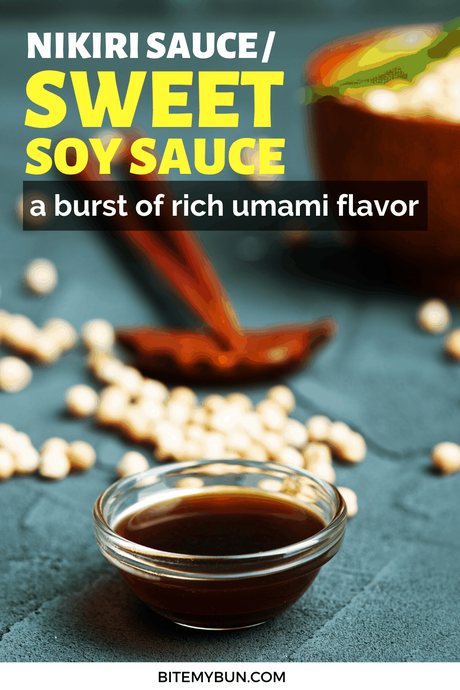
The nikiri soy-based sauce may not be everyone’s favorite sushi sauce, but it certainly deserves a mention here.
It is almost exclusively used for nigiri toppings and although made from soybeans, this sushi sauce has a rather light brown color and sweet taste.
And while the other sushi sauces have a thicker consistency, this one though has a thinner texture but offers a burst of rich umami flavor that is not found in any other sushi sauce.
Ingredients for the nikiri sauce:
- 1 cup of high-quality soy sauce
- 1 cup mirin
- 1/2 cup of homemade dashi (fish stock)
- 1 and 1/2 tablespoon sake
Get a small saucepan and place it on the stove, then set the temperature to low heat as you mix all the ingredients in it.
Allow the mixture to simmer until much of the liquid has evaporated (this should take about 15 – 20 minutes) and this will give you the perfect thickness syrup-like sauce.
Red spicy sushi sauce
What is the red sauce on sushi?
A lot of restaurants in America will serve a red spicy mayo sauce on some of their sushi rolls as it adds a nice kick to the dish. It’s made from may and chili sauce and commonly used on dragon rolls for example, but it’s not a traditional Japanese sushi sauce.
Sushi Sauce is a Fairly New Addition to the Sushi Cuisine
If you went back to pre-Meiji Era Japan, then you will find sushi dull and unimpressive because it does not come with the famous sushi sauce that people are accustomed to today.
The fact of the matter is that sushi sauces are a modern addition and are now common on most rolls. However, it is widely known that sushi chefs have been using a specially-made glaze for their nigiri even before the Meiji Era.
In modern times it is a common practice for sushi chefs to drizzle a sushi roll with 1 or more specially-made sushi sauces. Most of the sauces they make are in house, custom-made, and are highly secretive sushi sauce recipes that they rarely share. You may find sushi-grade sauces in some supermarkets, but they are not nearly as good as the homemade ones, or those made by sushi chefs for that matter.
A large number of these sauces are quite versatile and you can use them for different cuisines aside from sushi.
Here is a list of the various sushi sauces commonly found in sushi bars:
Most common sushi sauces
- Japanese Ginger Dressing – Commonly used in salads, but can also be used as a marinade for meat (here’s how to make ginger salad dressing)
- Spicy Mayo – The tried and true staple to most sushi bars in North America and it’s what most people refer to as “the red sauce on sushi”
- Eel Sauce – (Nitsume) – Traditionally used by the Japanese to complement their unagi (eel sushi roll)
- Garlic Mayo – Was first made in the United States, which is a fusion sauce that is both sweet and savory
- Miso Mayo – A sushi sauce made from miso paste that has a savory flavor
- Goma Dare (Sesame Oil) – Made from sake, miso paste, ponzu sauce, sugar, mirin, sesame oil, and a few other herbs and spices makes the Goma dare a very delicious choice for most sushi rolls
- Ponzu – A lightly citrus-infused soy sauce that is a wonderful alternative to salads and sushi
- Nikiri (sweet soy sauce) – A specially made sweetened soy sauce that’s used for glazing the fish ingredient in the sushi
- Yum Yum Sauce (AKA White Sauce or Sakura Sauce) – This is the sauce that most Teppanyaki/Hibachi grills as well as Japanese Steakhouses that’s excellent to pair with grilled beef, pork, and seafood
Everybody’s Favorite Black Sushi Sauce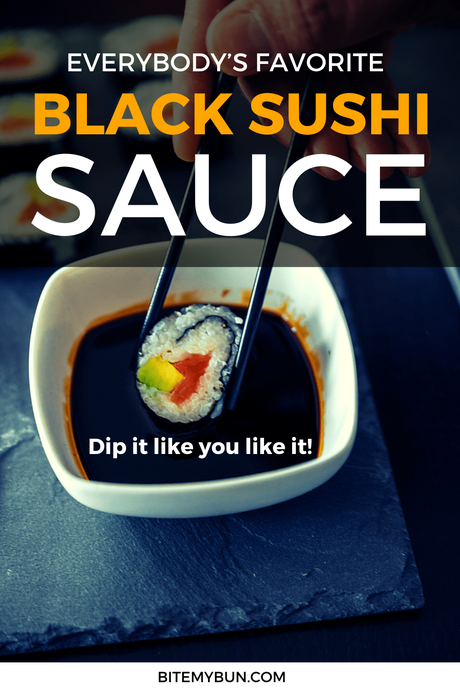
In case you’re not familiar with Japanese food, then we would like to extend our courtesy to you and tell you that we completely understand where you’re coming from, especially if you have little-to-no idea what that flavorful black sauce served with sushi is.
This black sushi sauce is crucial to making sushi taste great and without it, the sushi won’t be as satisfying. The Japanese cuisine offers more variations of this black sushi sauce compared to any other food culture in the world.
So, what is the black sauce on sushi? The black sushi sauce is within the gray area of the Japanese culinary arts (no pun intended) and there’s no way to tell which is which at first glance.
But you can guess which one it is when it is used to top sushi dishes, for instance, if it is drizzled on top of the sushi, then it might be teriyaki sauce and if the sauce has a thicker texture that’s almost similar to syrup, then it’s likely eel sauce (nitsume).
What is that black sushi sauce?
Sometimes the chef may also use tonkatsu sauce to drizzle those modern fusion sushi delicacies. Tonkatsu sauce has a tangy taste while Teriyaki sauce is traditionally made to be the sweeter variation of sushi sauces. Teriyaki sauce is very useful, in fact, it is the chef’s favorite sauce for most dishes including dragon roll, caterpillar roll, tempura shrimp roll, unagi, and many others.
In other cases, the light black sauce used on sushi could be chirizu sauce, which enhances the flavor of seafood like aji, halibut, and other types of shellfish. Ponzu sauce can also be used as a good alternative to sushi sauces due to its typical sweet taste and it also has a reddish-black color too!
You’d be surprised to know that all of these sauces that range from brown-black in color are all based on the age-old soy sauce, which varies only slightly in terms of flavor, taste, color, and texture.
If the sauce is served in a separate bowl as a dipping sauce, then there’s a high possibility that it could be plain soy sauce, tamari sauce, ponzu sauce, or chirizu sauce.
Soy Sauce
The vinegared sushi rice, tuna fish, and soy sauce are the primary ingredients crucial to making a perfect sushi dish with a subtle flavor and aroma. Soy sauce is made by soaking soybeans in water and roasting and crushing the wheat, then salt is added to the mix and is processed until it is refined and gets that black color liquid.
The original soya sauce or shoyu gets its roots from ancient China. These days, we have 3 different types of soy sauce used for many dishes across the world.
The light soy sauce (the first type of soy sauce) has a reddish-brown color and it is used for dressing, dips, and marinating ingredients.
The dark soy sauce (the second type of soy sauce), on the other hand, has a caramel color to it with a thicker texture that can stain other ingredients and has a slightly sweeter taste.
With a higher concentration of wheat, the thick soy sauce (the third type of soy sauce) has a thicker and almost viscous texture. It also has a sweet taste to it and chefs often use it as a dipping sauce.
Don’t Waste Soy Sauce
This is a basic etiquette rule – do not waste any soy sauce as you eat sushi. Don’t leave behind a big puddle of sauce on the plate as this is frowned upon. Pour a small amount of soy sauce into a sauce cup. Dip the rolls into the sauce and refill as required. It’s better to add too little sauce than too much.
If you want to go all out, use a chopstick to brush soy sauce onto the roll lightly. This ensures only a slight amount of soy sauce gets added. If sushi is made well, it has enough condiments and flavors, thus you don’t need to exaggerate with sauces.
What is the best soy sauce for sushi?
Look for a high-quality soy sauce from a trusted brand.
Some soy sauces are more bitter than others. That’s why we suggest you try Kikkoman brand sauces.
This naturally brewed soy sauce has a balanced flavor. It is not too sweet and not too bitter. Therefore, it is the perfect flavor complement for rice. It is the best choice for dipping sushi in because it doesn’t make the food mushy and sticky, like cheaper soy sauces.
Black Sauce Used on Sushi
The black sauce varieties that you commonly see in sushi restaurants today are inspired by the Western California-style rolls. The traditional sushi dishes in Japan did not have so many varieties back in the 15th century.
Before modern times, the brownish-black soy sauce was only served as a dipping sauce for sushi rolls. But these days, there are at least a dozen different kinds of sushi sauces. You can try sauces at your favorite sushi restaurants. As well, you can buy a variety of Sushi sauces at Asian grocery stores or online.
Do know that each and every sushi dish served at your table has already been glazed with the right amount of soy sauce? The chef places the sauce on the fish part of nigiri or on the toppings or fillings. This gives the sushi a balanced flavor.
Sauce Flavor Combinations
According to sushi etiquette, each sushi roll is has a perfect balance of flavors. The sushi chefs work hard to enhance the natural flavors of each ingredient. Since the chef makes the food flavorful it’s not necessary to load up on too much sauce. If you’ll add any more sushi sauce, it ruins that balance, therefore, you should avoid doing this. Some sushi chefs marinate or grill the ingredients with soy sauce to enhance flavor.
As well, recipes made with raw fish taste better with soy sauce. On the other hand, with uramaki (inside-out rolls), the traditional black sauce which comes in different variations is used for decorative purposes.
The chef may use teriyaki sauce, tamari sauce, or plain dark soy-sauce to drizzle over the sushi toppings. This enhances the aesthetic features of the sushi dish more than to make it taste great.
As the sushi evolves with more fusion recipes and contemporary ideas, you can find chefs using their own custom or secret soy-sauce recipe to differentiate from others.
In modern sushi cooking art, you will find that chefs have become accustomed to preparing sushi with one or more complementary sauces on their sushi rolls.
Also read: this store-bought stir fry sauce is really great
Bonus Sushi Sauce for Those Who Like it Spicy – Wasabi Sauce
Wasabi paste is one of the most popular sushi toppings. But, did you know you can make your own spicy wasabi sauce at home? It’s an easy way to add extra flavor and spiciness to any sushi roll. You’ll love Wasabi sauce if you want to add some kick to your food.
Authentic wasabi is quite expensive, so sushi fast food restaurants offer a substitute with a similar taste.
Wasabi is Japanese horseradish and it is more pungent than Western horseradish varieties. The paste is made with Kudzu. People say it tastes like a mixture of horseradish and mustard. You can recognize Wasabi paste by its green color and powerful scent.
We are sharing a wasabi sauce recipe with you. It is easier to dip sushi rolls in the sauce than the paste.
Homemade Wasabi Sauce Recipe
Ingredients:
1/4 cup water
1/4 wasabi powder
1/2 tsp of Himalayan salt
1/4 cup vegetable oil
1 tbsp of mustard
1/4 cup of rice vinegar
Instructions:
Add wasabi powder, rice vinegar, and mustard to a food processor and blend on slow.
Next, add the water, and oil slowly and let the sauce thicken.
Add salt, and taste the sauce.
There you go, you have a simple wasabi sauce you can store in your fridge for up to 30 days.
The Bottom Line
Sushi rolls are flavorful and delicious on their own. But, a tasty sauce takes sushi to a whole new level. You can experiment with sweeter flavors like Nikiri soy sauce, or keep it classic with a black sauce.
Either way, the flavors of these sauces add some kick to any sushi or sashimi meal. Don’t be afraid to experiment with sauces and condiments.
But, keep in mind the #1 rule of sushi etiquette – don’t douse your sushi in the sauce!
